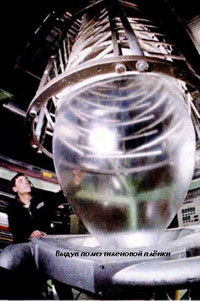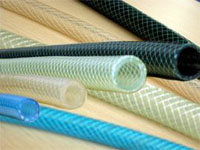


Production of polyethylene
The originator of a number of alkenes - ethylene was for chemists "hard nut" until 1933 the production of polyethylene is its polymerization of ethylene, a scientist could not get it.
Radical polymerization of ethyleneThe was opened first and, as is often the case, found it accidentally. In 1933, at experiments, to obtain a styrene from a mixture of benzene with ethylene at high pressure, the researchers identified transparent viscous mass from the reaction products, is the first sample polyethylene.
Four years later, in 1937, the English chemists developed the first industrial way to get polyethylene, and in 1946 began the production of plastic bottles.
To implement radical polymerization of ethylene as the initiator uses oxygen. A mixture of ethylene with oxygen in which the oxygen content is 0.01 %, heated to 200 °C under a pressure of 1000 ATM., this gives polyethylene:
Macromolecules such polymer have a lot of branches in the chain, and because the material is characterized by a low degree of crystallinity and low strength.
In 1954, Karl Ziegler and Giulio Natta opened a new organometallic catalyst, and due to production of polyethylene, they carry out at atmospheric pressure and a temperature of 60 °C.
Polymerization of ethylene at low pressure are often carried out in a mixture with higher alkenes: butene-1; hexene-1; 4-methylpentene-1, etc. for polyethylene of this type in molecules very little branching, it is regular, crystalline and strength.
Observed an interesting pattern: when high pressure is formed of low density polyethylene and strength, and low - on the contrary. Another difference: low pressure polyethylene haes high degree of polymerization: it reaches 300 000; and the high-pressure polyethylene - 50 000.
Polyethylene is one of the most common synthetic polymers. It is a well-known plastic film - beautiful packaging material, and corrosion-resistant polyethylene pipes, and lightweight, easy to handle utensils.
Polypropylene
The closest homologue of ethylene - polypropylene. In 1955-1956, Giulio Natta managed to get polypropylene regular structure by ion polymerization using a complex catalyst based on triethylaluminum (C2H5)3Al and titanium tetrachlorideTiCl4.
Polypropylene relative polyethylene has valuable properties: it has a high softening temperature (about 170 °C), higher stiffness and strength than polyethylene. Because of these properties, as well as availability of the initial monomer, polypropylene is used in the manufacture of pipelines, chemical equipment and various household items.
Polystyrene
When replacing one of the hydrogen atoms in the molecule of ethylene in benzene nucleus, it gets a new polymer - vinylbenzyl (styrene) CH2=CH-CN.
Radical polymerization of styrene leads to the formation of irregular polystyrene: In such irregular polymer macromolecules containing large non-polar substituents, can't form crystals. So polystyrene easily melts and dissolves in many organic liquids, and at room temperature is in the amorphous state. At 100 °C polystyrene softens, and at 185 °C it turns into a viscous liquid.
Polystyrene widespread because of its cheapness and ease of processing. However, it has one serious drawback - it is very fragile and brittle material, what can make sure everyone stepping on the body of a ballpoint pen. The transparent housing pens, boxes of cassettes and laser discs, toys, Souvenirs and other items that do not require high strength material, all of them are made of polystyrene.
Polyvinyl chloride
If eplace the ethylene atom of hydrogen with chlorine, then formed another monomer - vinyl chloride CH2=CH-Cl. For the first time its polymerization was carried out in 1872, a German chemist Eigen Bauman (1846 - 1896). The merit of this researcher was to develop a method of radical polymerization of vinyl chloride in the presence of organic peroxides.
This produces a regular polymer, the formation of which contributes to the high polarity of the molecules of vinyl chloride.
Active practical use polyvinyl chloride (abbreviated as PVC) started relatively recently - only since the middle of XX century. The Problem was that the net polyvinyl chloride has many disadvantages. At room temperature it is very brittle and inelastic. In addition, it is difficult to dissolve or melt, and this greatly complicates the processing of the polymer. In the 30's, scientists were able to find special substances, stabilizers, increasing the resistance of the polyvinyl chloride to the action of heat and light. New material is plasticized polyvinyl chloride is widespread. Now it is made insulation for electrical wires. Here it drove more fuel and less chemically resistant rubber. Rain coats, toys, parquet tiles, one kind of artificial leather - this is not a complete list of everyday objects made from the "oldest" polymer - polyvinyl chloride.